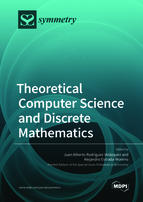Theoretical Computer Science and Discrete Mathematics
A special issue of Symmetry (ISSN 2073-8994). This special issue belongs to the section "Computer".
Deadline for manuscript submissions: closed (30 November 2021) | Viewed by 29807
Special Issue Editors
Interests: graph theory; applied mathematics; discrete mathematics
Special Issues, Collections and Topics in MDPI journals
Interests: graph theory; applied mathematics; discrete mathematics; computer science
Special Issues, Collections and Topics in MDPI journals
Special Issue Information
This Special Issue is devoted to original and significant contributions to theoretical computer science and discrete mathematics. The aim is to bring together research papers linking different areas of discrete mathematics and theoretical computer science, as well as applications of discrete mathematics to other areas of science and technology. The issue covers topics in discrete mathematics including (but not limited to) graph theory, coding theory, cryptography, algorithms and complexity, discrete optimization, discrete geometry, and computational geometry. Contributions presented to the issue can be original research papers, short notes or surveys.
Prof. Dr. Juan Alberto Rodríguez Velázquez
Dr. Alejandro Estrada-Moreno
Guest Editors
Manuscript Submission Information
Manuscripts should be submitted online at www.mdpi.com by registering and logging in to this website. Once you are registered, click here to go to the submission form. Manuscripts can be submitted until the deadline. All submissions that pass pre-check are peer-reviewed. Accepted papers will be published continuously in the journal (as soon as accepted) and will be listed together on the special issue website. Research articles, review articles as well as short communications are invited. For planned papers, a title and short abstract (about 100 words) can be sent to the Editorial Office for announcement on this website.
Submitted manuscripts should not have been published previously, nor be under consideration for publication elsewhere (except conference proceedings papers). All manuscripts are thoroughly refereed through a single-blind peer-review process. A guide for authors and other relevant information for submission of manuscripts is available on the Instructions for Authors page. Symmetry is an international peer-reviewed open access monthly journal published by MDPI.
Please visit the Instructions for Authors page before submitting a manuscript. The Article Processing Charge (APC) for publication in this open access journal is 2400 CHF (Swiss Francs). Submitted papers should be well formatted and use good English. Authors may use MDPI's English editing service prior to publication or during author revisions.
Keywords
- graph theory
- coding theory
- cryptography
- algorithms and complexity
- discrete optimization
- discrete geometry and computational geometry







